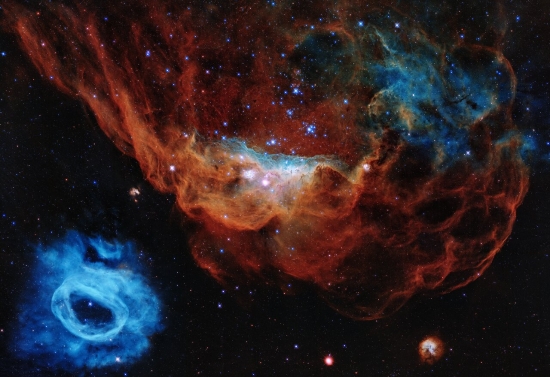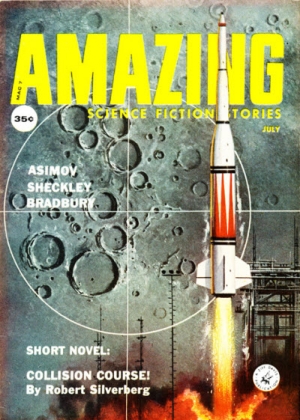Somehow it feels as if the Hubble Space Telescope has been with us longer than the 30 years now being celebrated. But it was, in fact, on April 24, 1990 that the instrument was launched aboard the space shuttle Discovery, being deployed the following day. 1.4 million observations have followed, with data used to write more than 17,000 peer-reviewed papers. It’s safe to say that Hubble’s legacy will involve decades of research going forward as its archives are tapped by future researchers. That’s good reason to celebrate with a 30th anniversary image.
I’m reminded that the recent work we looked at on the interstellar comet 2I/Borisov involved Hubble as part of the effort that detected the highest levels of carbon monoxide ever seen in a comet so close to the Sun. Using Hubble data is simply a given wherever feasible. And given yesterday’s article on star formation and conditions in the Sun’s birth cluster that may have produced leftover material from other stellar systems still orbiting our star, it’s worth noting the portrait Hubble just took of two extraordinary nebulae that are part of a star-formation complex.

Image: This image is one of the most photogenic examples of the many turbulent stellar nurseries the NASA/ESA Hubble Space Telescope has observed during its 30-year lifetime. The portrait features the giant nebula NGC 2014 and its neighbor NGC 2020 which together form part of a vast star-forming region in the Large Magellanic Cloud, a satellite galaxy of the Milky Way, approximately 163,000 light-years away. Credit: NASA, ESA, and STScI.
Here we’re deep in the Large Magellanic Cloud. This is a visible-light image showing NGC 2014 and NGC 2020, which although appearing separate here, are part of a large star-forming region filled with stars much more massive than the Sun, many of them with lifetimes of little more than a few million years. Dominating the image, a group of stars at the center of NGC 2014 has shed the hydrogen gas and dust of stellar birth (shown in red) so that the star cluster lights up nearby regions in ultraviolet while sculpting and eroding the gas cloud above and to the right of the young stars. Bubble-like structures within the gas churn with the debris of starbirth.
At the left, NGC 2020 is dominated by a star 200,000 times more luminous than the Sun, a Wolf-Rayet star 15 times more massive than our own. Here the stellar winds have again cleared out the area near the star. According to the ESA/Hubble Information Center, the blue color of the nebula is oxygen gas being heated to 11,000 degrees Celsius, far hotter than the surrounding hydrogen gas. We should keep in mind when seeing such spectacular imagery that massive stars of this kind are relatively uncommon, but the processes at work in this image show how strong a role their stellar winds and supernovae explosions play in shaping the cosmos.

Inevitably I’m reminded of science fictional treatments of the Magellanics, especially Olaf Stapledon’s Star Maker (1937), in which a symbiotic race living in the Large Magellanic Cloud (LMC) is the most advanced life form in the galaxy. But let’s also remember that when Arthur C. Clarke’s starship leaves the Sun in Rendezvous with Rama (1973), it’s headed for the LMC. Among scores of other references, from Haldeman’s The Forever War to Blish’s Cities in Flight, I’m particularly fond of Robert Silverberg’s less known Collision Course, probably because a shorter version fired my imagination as a boy in a copy of Amazing Stories I still possess.
Image: The brilliant Cele Goldsmith was editing Amazing Stories by the time the July, 1959 issue containing “Collision Course” came out. The full novel would be published in 1961.
There is something about what you would see in the night sky from a satellite galaxy, as opposed to our own view of the Milky Way from within its disk, that fires the imagination. For an entirely different view of the galaxy, read Poul Anderson’s World Without Stars (1966), as discussed in these pages back in 2014 in The Milky Way from a Distance.



A very, very large (its subject matter, that is) wish that I once made came true. Having always admired the beauty of barred spiral galaxies (galaxies in which the arms spiral outward from the ends of a prominent, usually yellow-glowing, “bar” of stars; the two arms sometimes wrap around many times), years ago I wished that we lived in such a galaxy, and:
Not too long after that, astronomers–radio astronomers, if memory serves–announced that our Milky Way actually *is* a barred spiral galaxy, its multiple-wrapped spiral arms streaming from a moderately-sized bar that passes through the spin axis of our galaxy. What a glorious view that must be, to see rising over a planet’s horizon well after sunset, from either of the Magellanic Cloud satellite galaxies!
A. E.Van Vogt wrote the novel “Mission to the Stars” which,IIRC, involved a star cruiser (something like that) traveling through the Magellanic cloud. The ship encounters an interstellar storm that breaks the ship into still-functional parts (as intended in such circumstances). Some of the characters end up on a dinosaur world. They cleverly deduce that the planet orbits the star S. Doradeus(?) with a luminosity of 500,000 times that of our sun. All of the foregoing is from a distant memory.
Good catch! Thanks.
Whew! Their planet’s year must have been, well…astronomically long (to be orbiting far enough from S Doradus [whose luminosity varies widely above and below *one million* times the Sun’s luminosity: https://en.wikipedia.org/wiki/S_Doradus ] to ^not^ be liquid rock!).
The planet would need to orbit about 1,000 AU from the star! Yes, a very long year indeed. Perhaps the orbit would be unstable given how weak the star’s gravity would be at that distance (even considering its higher mass relative to the sun). Van Vogt did not consider that the life time of such a star is a few million years; hardly enough time for any form of life to evolve. Still, I like Van Vogt and his Voyage of the Space Beagle is a true SF classic.
1000 AU is only twice as far as our own Sedna can travel, making the period 2^(3/2) longer, but the star is 24 times heavier, making it 24^(1/2) shorter, so the period of such a planet would be 12000/1.7 years, I think. Nothing truly out of the ordinary, though I would like Planet Nine hunters to deliver something more interesting to compare it to.
As commented on by other Southern Hemisphere observers in 2014, the LMC is rather underwhelming to a naked eye observer. The few people who notice it at all probably think it is a stray wisp of the Milky Way rather than a separate object. The SMC is even harder to appreciate with the naked eye.
The large aperture Hubble time exposure looks glorious, but a view from the porthole of a nearby spaceship would appear very faint and lacking the spectacular colours. In this case a telescopic view is better than being there.
Have Space Suit, Will Travel by Heinlein also involved them; the “Three Galaxies” organization the protagonists get involved with administers matters in the Milky Way and both Magellanic Clouds.
Thanks! It’s been so long since I’ve read that one, but you’re absolutely right, Christian.
One more from memory: Iain M. Banks’ ‘The Player of Games’, from his Culture series, involves a bloodthirsty game-playing civilisation in one of the Magellanics, and the bulk of the action of the novel happens there–though it’s really only the long travel time to get there that forms a plot point.
Great! I was hoping someone would bring that up — I was about to myself. I really liked that setting for Player of Games, and should have mentioned it in the article.
Some Star Trek novels mention them.
The Final Fury, Taking Wing, and The Red King have the Small Magellanic Cloud and the novel version of The Motion Picture mentions a starship called the USS Magellanic Cloud.
In the novel Objective:Bajor the Hive species fled the Clouds when another species began conquering it.
And in the DS9 episode “The Nagus” scientists guessed the LMC was the origin of the flying parasites from the Original series episode Operation: Annihilate.”
Thanks, Stephen. You clearly know Trek lore! Haven’t read any of these, so I appreciate the pointers.
While, I don’t look into what Hubble has shown. I saw a film years back on youtube, the former Astronaut who walked on the moon, on mission 11. He speculated in half a year of the telescope being launched that it could be discovered that there, could be life elsewhere. I sent a tweet to Mr Aldrin some years back, but he never responded on this.
I am not sure, why he thought this telescope could somehow pin point a habitable planet or a space station somewhere else. Perhaps he didn’t understand what it would see or how it could work. It was an odd comment to make considering, the telescope hasn’t identified or could do so anywhere with possible life.